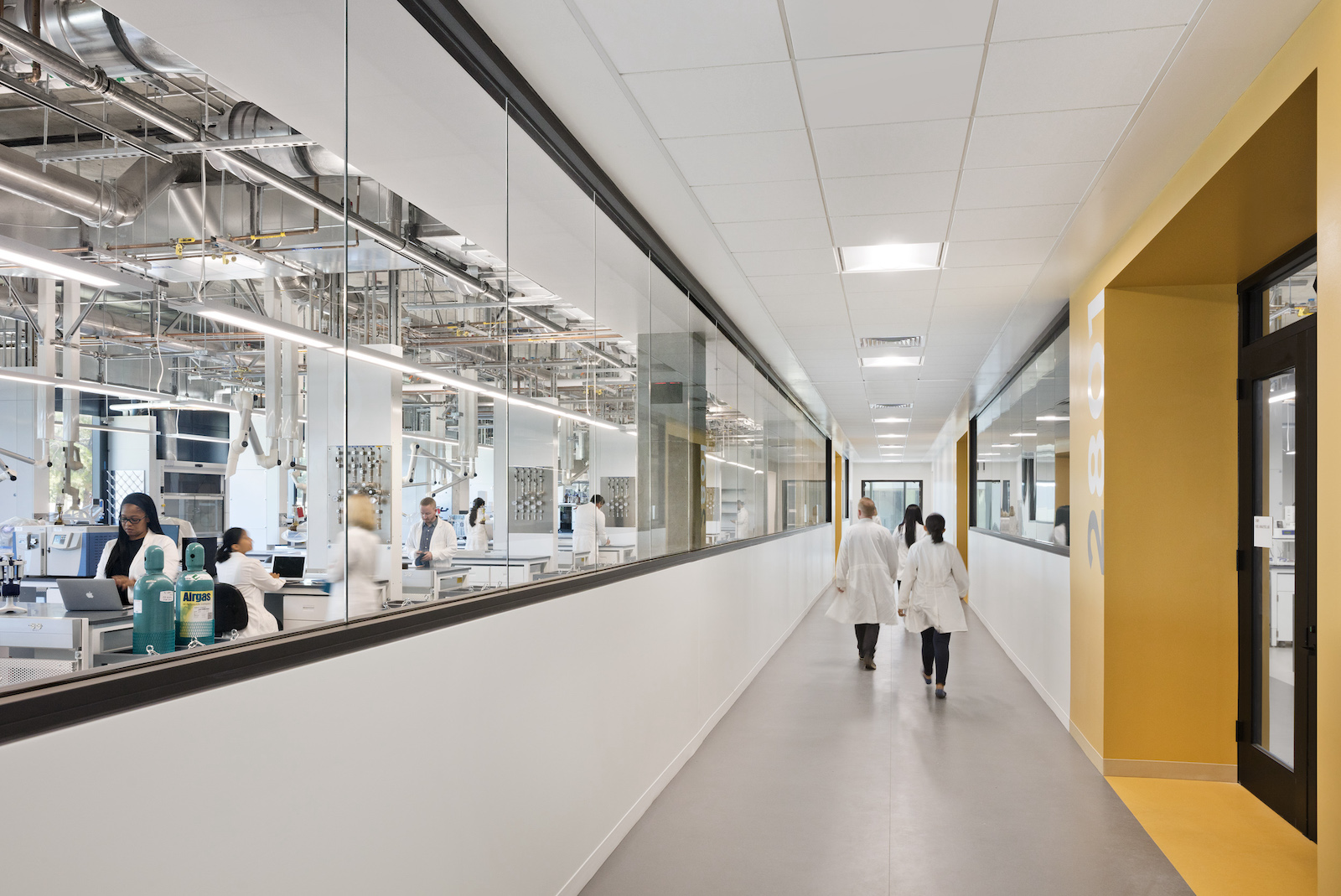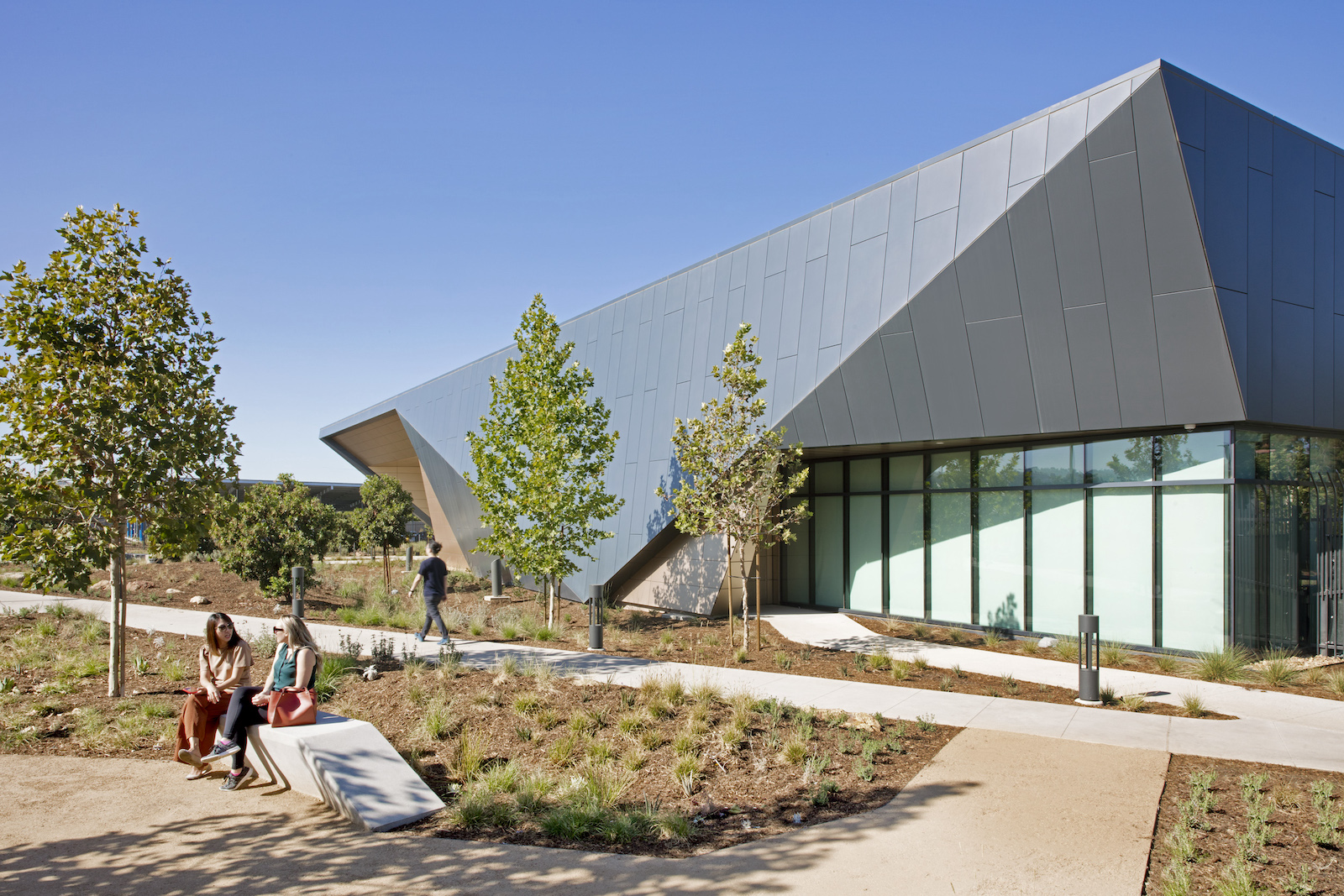The California Air Resources Board (CARB) Southern California headquarters has been completed in Riverside, Calif. The 403,306-sf is the largest vehicle emissions testing facility in the world and the largest net-zero facility of its kind.
The CARB headquarters exceeds California Title 24 requirements by 30% and lowers energy cost savings by 75%. All of the energy needed is produced onsite, making it resilient to power outages and protecting it from pausing its research operations.
CARB consolidated five existing locations across Southern California into CARB’s headquarters which improves performance and efficiency of operations while also providing a healthy workplace for the organization’s employees. The design team’s focus was not just reaching high-performance targets, but creating a quality environment for CARB’s employees.
The features of the headquarters include a complex program with myriad space types, including a main entrance and lobby, an employee entrance and lounge, a large auditorium, open office, conference room, light-and-heavy-duty vehicular emissions testing wings, specialized chemistry and hydrogen laboratories, and employee amenity spaces such as an expensive breakroom and a gym. The facility is sited on 19 acres to encourage biking, walking, public transit, and use of zero emissions vehicles to reduce transportation impacts.
The facility effectively connects users to the outdoors. The layout and form of the building establishes two principle outdoor spaces: the main courtyard to the east and a more private courtyard to the west. The building is oriented around the courtyards to lend itself to easy circulation, views, daylighting, and self-shading. Coupled with an abundance of low B VOC-emission trees and plantings, comfortable outdoor respite spaces are established for employee enjoyment.
The massing of the office building is consolidated into three stories that extend in three directions parallel to light duty testing, chemistry labs, and toward the conference buildings. This creates a smaller building footprint and shortens horizontal circulation networks, while using vertical connectivity established by a network of bridges and stairs to increase proximity between offices, testing areas, support spaces, and laboratories, resulting in increased flexibility, optimized adjacencies, and greater opportunities for intellectual collisions among employees. A variety of types and scales of meeting spaces, as well as coffee bars and cafés promote interaction and collaboration, especially for staff who circulate between the various departments throughout the day.
The ground floor of the open office atrium features testing control desks where employees conduct and operate the air regulation testing that occurs in the test cells. These inset spaces throughout the office building first floor are open and allow all users to see the AC dynamometers, among other testing equipment, in action.
Beyond putting CARB vehicular testing on display, the energy reduction strategies in the office building also largely contribute to the facility’s net-zero energy status. The integration of chilled beams allowed the atrium ceiling to be kept high, making way for the collection of skylights—a passive lighting strategy—that create expansive views of the naturally lit workspace. Paired with task lighting and daylighting harvesting, the office wing, which accounts for 41% of the total program, uses only 15% of the total energy needed to operate the building.

Energy reduction strategies include:
- Fluid cooler - Using hybrid coolers in conjunction with an elevated 570°F chilled water temperature reduced estimated energy consumption of the facility by approximately 8%.
- Aircuity and demand control ventilation - Continuous indoor air monitoring maximizes ventilation efficiency and energy reduction.
- Adiabatic humidification - Air is humidified without using steam or an additional heat source, reducing energy consumption.
- Active chilled beams - The hydronic air cooling system uses less air, reducing energy requirements and overall operating costs.
- Daylighting - Skylights increase interior daylighting. Motorized interior shades reduce glare.
- Lighting - Site lighting: high efficiency LED site in parking. Interior lighting: interiors incorporate all LED lighting, task-ambient lighting, daylight harvesting control, dual lighting / HVAC occupancy sensors.
- Electrical vehicle charging - 118 EV charging stalls provided on site with the ability to expand to a total of 149 EV parking stalls.
- Fume hood occupancy-based control - Occupancy-based sensors integrated into the chemistry lab fume hoods reduce energy demands.
- Exterior louvers - Exterior louvers integrated into the southeast and west facades reduce solar heating and glare.
- High-performance glazing - Low-e insulated glazing with exterior louvers increase operational energy efficiency.
The facility was completed in August 2021. ZGF worked with Hensel Phelps and Affiliated Engineers on the project.
Related Stories
| Mar 26, 2014
Callison launches sustainable design tool with 84 proven strategies
Hybrid ventilation, nighttime cooling, and fuel cell technology are among the dozens of sustainable design techniques profiled by Callison on its new website, Matrix.Callison.com.
| Mar 20, 2014
Common EIFS failures, and how to prevent them
Poor workmanship, impact damage, building movement, and incompatible or unsound substrate are among the major culprits of EIFS problems.
| Mar 17, 2014
Rem Koolhaas explains China's plans for its 'ghost cities'
China's goal, according to Koolhaas, is to de-incentivize migration into already overcrowded cities.
| Mar 12, 2014
14 new ideas for doors and door hardware
From a high-tech classroom lockdown system to an impact-resistant wide-stile door line, BD+C editors present a collection of door and door hardware innovations.
| Feb 27, 2014
Open or private offices? It depends on the business plan
Open layouts are grabbing headlines as a hallmark of the new workplace—think the Google campus or Facebook's headquarters. And for smaller-scale operations, open designs are often lauded for being less expensive than private office plans. But does that mean all offices should have an open layout?
| Feb 21, 2014
Calatrava ordered to pay millions for 'shortcomings in his work' on conference center project
Famed architect Santiago Calatrava must pay 2.9 million euros due to faulty design work on the Palacio de Congresos project in Oviedo, Spain.
| Feb 14, 2014
Crowdsourced Placemaking: How people will help shape architecture
The rise of mobile devices and social media, coupled with the use of advanced survey tools and interactive mapping apps, has created a powerful conduit through which Building Teams can capture real-time data on the public. For the first time, the masses can have a real say in how the built environment around them is formed—that is, if Building Teams are willing to listen.
| Feb 12, 2014
First Look: Futuristic Silicon Valley campus designed to draw tech startups
The curved campus will consist of four different buildings, one exclusively for amenities like a coffee bar, bike shop, and bank.
| Feb 6, 2014
End of the open workplace?
If you’ve been following news about workplace design in the popular media, you might believe that the open workplace has run its course. While there’s no shortage of bad open-plan workplaces, there are two big flaws with the now common claim that openness is bad.
| Jan 30, 2014
The evolving workplace: One designer's inspiration board
"Open office" has been a major buzzword for decades, and like any buzzword, some of the novelty has worn off. I don't believe we will abandon the open office, but I do think we need to focus on providing a dynamic mix of open and closed spaces.

















